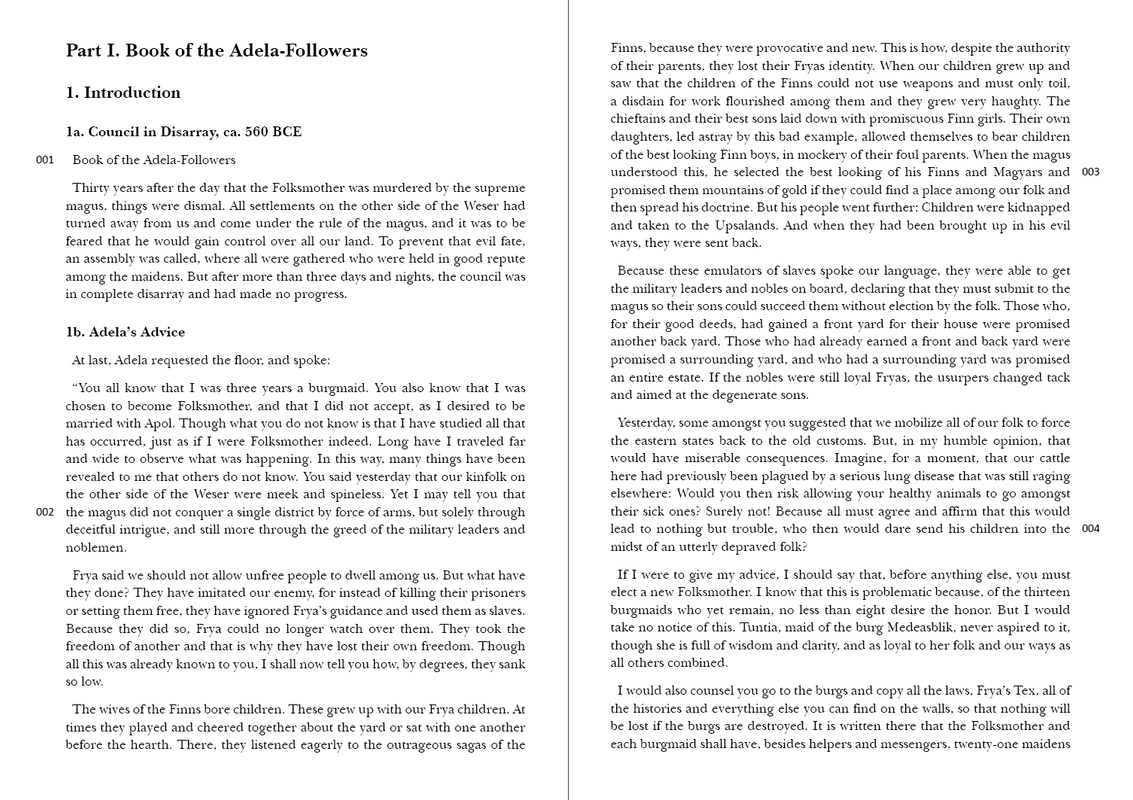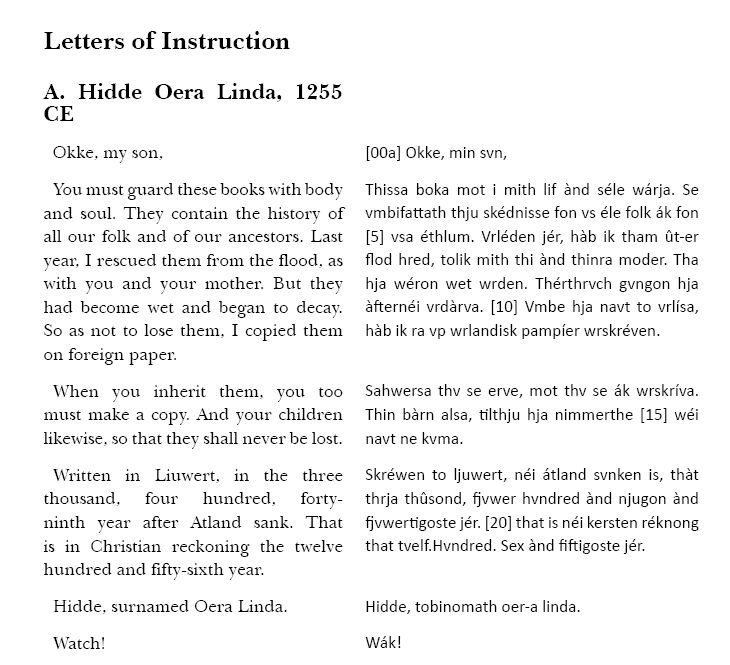About the future
deluxe edition:
Have you considered arranging the text into chapters and verses? It would make working around footnotes more easy and making it possible to have more of them, including the Index of Names in the end similar to the latests english versions.
Other than that, looks good, but I personally would prefer some possible font where the lowercase letters were a bit bigger, because at least my eyes are not really used to alternative letters and I often find myself squinting while reading text like that. Maybe it is just me!
I think that modern readers are becoming more and more dislocated from old sources along the writings that mention them, so to give the codex the value it deserves it could have pages of images about various topics besides the codex. Just bump up the prize, I'm sure people are willing to buy it. Just to give an example, many images found from here:
https://fryskednis.blogspot.com/2020/03 ... ed-to.html
So by placing more written content per page -> more space for images. Just an idea!
To add to the last source, here's images based on the carving inside the Royston Cave, propably left back by some templar prisoners, right page, lower left corner:
https://archive.org/details/originuseof ... ew=theater
About the edition that would have
only the translation, because the language of the codex plays such importance:
#1.
I wish that the contents of codex in the the pages 045-047 and could be included in a similar way it was done in revised edition, with both litteration and translation, in all future editions. This opens more possibilities to make use of footnotes
(when refering to the pages 045-047 of the codex, or more; some parts onwards to the page 049, also 082-085 and 157-163?), which in my opinion should be plenty, especially relating to the ''religious'' (world view) aspects, and this way would make the translation more rich. ''aewa also means ‘ae-like’ — water-like''
Further regarding footnotes like I described, about words found from the codex, through that constructing the written language
can be explained in short. Examples of some possible correlations, distinctions and other things from fryskednis-blog, including some examples of ideas by me:
''Problem'' of universals?
https://en.wikipedia.org/wiki/Problem_o ... sals#Plato
To be or not to be?
https://en.wikipedia.org/wiki/To_be,_or_not_to_be#Text
OL 00a: OER.A LINDA,
OL 00b: OVIRA.LINDA
OL 099: WR.ALDA IS THET ALDER.ALDESTA JEFTHA OVER.ALDESTA.
Wr-alda’ is the most-ancient or primordial (‘
over-oldest') ...
OL 087: THRVCH MIN FOLK BEN IK KÉREN TO GRÉVETMÁN OVIRA LINDA WRDA.
My folk elected me to be reeve
over the Linde regions.
OL 113: MIN NÔM IS FRÉTHO.RIK. TONOMATH OERA.LINDA. THÀT WIL SEZA OVIR THA LINDA.
My name is Frethorik, surnamed Oera Linda, which means ‘
over the Linde’.
---- WR.ALDA, WRDA, VR.TÁLA? : Over-, Un-/Not-same (meaning not remaining, always changing, beyond description?)
https://fryskednis.blogspot.com/2022/07 ... guage.html
https://fryskednis.blogspot.com/2019/05 ... -wrda.html
LÉJEN, LEST, MISTRÍVWA, BIWLA : Truth and lying
https://fryskednis.blogspot.com/2020/11/lejen-lie.html
https://fryskednis.blogspot.com/2020/11 ... yness.html
https://fryskednis.blogspot.com/2013/10 ... ruids.html
https://fryskednis.blogspot.com/2022/10 ... efoul.html
TOCHTA vs. NOCHTA
https://fryskednis.blogspot.com/2012/06 ... ughts.html
https://fryskednis.blogspot.com/2011/11 ... words.html
ÉR, ÉRSÉKE & -HÉD, -NES/-NIS
https://fryskednis.blogspot.com/2023/01 ... -once.html
https://fryskednis.blogspot.com/2023/01 ... ffect.html
https://fryskednis.blogspot.com/2011/10 ... s-nis.html
https://fryskednis.blogspot.com/2022/10 ... kness.html
RIP & BÉRA : Ripe and to give birth-bear-make bare-happen
https://fryskednis.blogspot.com/2014/09 ... appen.html
https://fryskednis.blogspot.com/2020/08/rip-ripe.html
OL 012: NIM NÀMMAR KNI.BUWGJANDE TÁNK FON.JV NÉSTON ÁN.
Never accept your neighbors to thank you with bended knees. ---- NÉSTON, NÉSTA vs. KNI, KNÍ, KNY : Kinsmen, Knee-men?
https://fryskednis.blogspot.com/2020/06 ... nship.html
https://fryskednis.blogspot.com/2015/11 ... arest.html
LÁWA, LJAWA, LJAFDE, LOV : Love and praise
https://fryskednis.blogspot.com/2021/04 ... words.html
https://fryskednis.blogspot.com/2018/02 ... -laud.html
HOF, GARA, GÁRDUM, DÉL, WÀRF, WÀRV : Gardens, palaces and yards
https://fryskednis.blogspot.com/2021/11 ... arden.html
https://fryskednis.blogspot.com/2012/06 ... -gara.html
https://fryskednis.blogspot.com/2021/04 ... wharf.html
OL 033: MINA
ERVA DRÉG IK OM IN MINA BOSM. ERVA ---- WARA, WÁRJA : Inheritance and treasure (''The heart of -''?)
https://fryskednis.blogspot.com/2022/12 ... -wara.html
PIL : Pijl, pijler, pilaar
https://fryskednis.blogspot.com/2013/09 ... -piel.html
SIAK : Sick
https://fryskednis.blogspot.com/2018/07 ... kness.html
And, separate footnotes that regard historical subjects of the writings, examples from the blog:
The meaning of FRAN(A) in the OLB
https://fryskednis.blogspot.com/2011/06 ... rance.html
PAPER from POMPIER
https://fryskednis.blogspot.com/2011/12 ... mpier.html
HEX, HEXNA and the six-spoke wheel
https://fryskednis.blogspot.com/2017/10 ... witch.html
''SKRÉVEN''
https://fryskednis.blogspot.com/2011/05 ... riuin.html
FODDIK : LAMP
https://fryskednis.blogspot.com/2022/08 ... flame.html
D is for Del-ta
https://fryskednis.blogspot.com/2011/05 ... el-ta.html
VAMPÍRA
https://fryskednis.blogspot.com/2016/03 ... eches.html
Including names of places and burgs!
#2.
Some emphasis regarding the symbolical aspects - for example the Minerva's owl or horses:
https://fryskednis.blogspot.com/2019/03 ... s-owl.html
https://fryskednis.blogspot.com/2013/09 ... rider.html
#3.
Some short essays maybe? Other interesting subjects:
How did the OLB vowels sound?
http://aldfryas.blogspot.com/2020/05/ho ... sound.html
NG-letter ~ separate N-G ~ finger
https://fryskednis.blogspot.com/2015/04 ... inger.html
Brahmi script origin similar to OLB script?
https://fryskednis.blogspot.com/2019/04 ... o-olb.html
The Great Remigration
https://fryskednis.blogspot.com/2017/07 ... 0-bce.html
https://fryskednis.blogspot.com/2018/05 ... other.html
Hope this is of help

